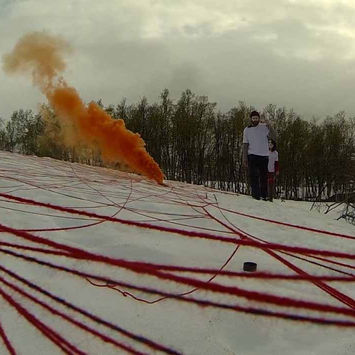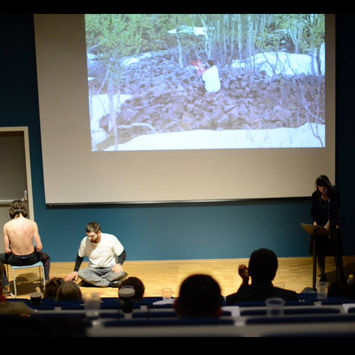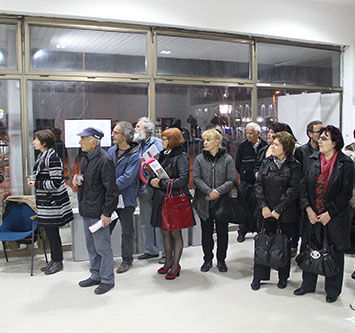
EXHIBITION - PRIMA CENTAR BERLIN
29.09.2017 - 19.10.2017
EXHIBITION - CULTURE CENTER "MARKO CEPENKOV" -PRILEP, MACEDONIA
15.09 - 22.09.2017
A PART OF ME
An Art Exhibition (photos and short videos as a part of the video performance)
„ YOUR PERCEPTION OF ME IS A REFLECTION OF YOU,
MY REACTION TO YOU IS AN AWARENESS OF ME“
It’s often heart that artists live in their own world, that they are different from the others. But the artist, as everyone else, are part of the societal life and often times their expression is a reflection of the ongoing social changes in the society.
The project is carried out by two artists who live in the Pelagonia region. In this part of Macedonia the tobacco is still one of the main sources of income for many families.
There are many artist from this region in whose works the tobacco has been the main theme.
Ferdi comes from a rural environment, and has been directly involved with the production of the tobacco since he was a child . Darko, on the other hand, coming from a town, has never been directly involved, but is well familiar with the entire process of tobacco cultivation due to the environment. One artist is of Turkish and the other of Macedonian nationality, which further enriches their artwork.
In the project ‘Part of me’ the sackcloth (a rough cloth used when packing the dried out tobacco) is taken to be the main material. The sack cloth carries the smell of the tobacco and it sticks to it in the same way that it sticks to the people who work with it in the fields.
Ferdi uses the sack cloths as his second skin because the skin is, in a way, a memory of life. He faced the hardship brought about by tobacco production when still a child, so the photographs and videos portray that. Pressed between the smell and the weight of the tobacco he is trying to get rid of them. No matter how strong and complete the separation, it leaves marks. That is the reason why in some photographs the’ second skin’ is shown and this time the material is a cling film. It is actually a symbol of the marks the society lives on a person. The difficult conditions, inevitably lead to people trying hard find a way out. They are trying to escape the smell of the tobacco leaves and the firm grip of the sack cloth.
Darko has been experimenting with his skin condition (which he incidentally discovered) for the last 2 years. Demography (or skin painting/ drawing) has become his medium of expression. This is how Darko sees it:
The skin is a covering of the body that both ‘protects us from others and exposes us to them. What I find interesting from the book "Thinking through the skin" by Sarah Ahmed and Jackie Stacey, is a thinking that reflects, not on the body as the lost object of thought, but on inter-embodiment, on the mode of being-with and being-for, where one touches and is touched by others. That how my skin become reflection of my personality.
Often his artwork is related with his attempts to espouse the other people emotions and interpret them in his own way – walk in other peoples’ shoes. The Macedonian proverb for the same would be roughly translated as ‘ to be/live in someone else’s skin’, so in this project the artist does just that: He is using his skin to interpret the other artist emotions, at the same time interweaving his own.

A PART OF ME
 |  |  |  |  |
|---|---|---|---|---|
 |  |  |
 |  |  |  |  |
|---|---|---|---|---|
 |  |  |  |  |
 |  |  |  |  |
|---|---|---|---|---|
 |  |  |  |  |
 |  |

19 August - 17 September 2017
Mutant Man
Mutant Man features six video works of computer animation, performance, and hand-drawn animation from the works selected by the 2015 MOCA Video open-call-for-work program. With different perspectives, the six videos discuss how social situations have contributed to human's altered physical perception. Discord, pressure and alienation in contemporary society have caused a break between people's physical perception and the self, other, and environment, transforming them into de-familiarized, frenzied, and mutated bodies.
Five artists are showcased in Mutant Man. Romanian artist Monica Vlad's :interrupted reveals a series of constantly disappearing images of memory and emotional connection, representing human existence in a state of solitude and disintegration. Macedonian artist Darko Taleski has dermatographia. In Help Refugees, he writes down pleas for helping European refugees on his body, epitomizing people's anxiety and discomfort regarding the chaotic international situations on his skin. Zheng Yo-Cheng's The Crazy is inspired by Lu Xun's A Madman's Diary, and depicts the cruelty and shackles imposed by contemporary society, which lead to people's psychological repression, breakdown and escape. In Building, Building, Lin Wang-Tin aims to address how modern urban development has led to a life in cold and modularized buildings. The condition of "non-homes" has transformed people into unfeeling objects, moving but not living. With hand-drawn animation, Young Gym-Jack's The Useless Cha-cha and Everyday’s a Holiday delineate surrealistic bodies that undergo continuous mutations through fantasies in life.

達可‧塔雷斯基 Darko Taleski
援助難民是藝術家的國家過去一年來必須面對的情況,許多難民越過國界,希望到西歐㝷求更理想的未來,他們之中大多數人選擇在夜黑風高的時候,沿著鐵路行進,有的人因此發生意外,遭火車撞上,藝術家希望透過這件錄像作品讓國內的主管機關了解,他們必須要有所作為來幫助這些人。
Help refugees is a reflection of the situation that have happening from last year in the artsist’s country. There are many refugees that crossing the border and goes to the Western Europe looking for better future. Most of them are going by the railway line at night. Some of them are hit by the train. This is video is a messages to the artsist’s country authorities that they must do something to help this peoples.
〈協助難民 Help Refugees〉
單頻道錄像 Video
1’
2015


15 - 22 June 2017
War remembrance through art - Norway
On the occasion of the 75th anniversary of the Beisjord tragedy, a group of artist from Serbia, Macedonia and Norway have created a video-performance and built a temporary monument at Øvre Jernvannet in Narvik.


Beisfjord Remembrance


6 - 16 April 2017
Art without borders
Macedonian encounter
Curated by Marilena Bianchi Streit
The aim of this exhibition is that Art has no borders. A variety of artists, most of them young, having different cultural backgrounds and artistic education are presented here linking Europe with Africa and the Middle East. The artists have expressed their creativity - some with painting or with drawings or media or photography or sculptures and the curators did not forget poetry. Humanity, in what Zigmunt Bauman defined liquid modernity, is so much in need of poetry and dreams. In the continuous connected world, individuals are building different cognitive frames and modes of action. However, the view of the artists will remain individualistic and/or poetic even when they are trying to use, and in some cases abuse, the power given to them by new technologies. Artists always will reflect the society in which they live, whether they conform to it, question it or reject it. If you question the role of the artist in today’s society, come and spend some time looking at the paintings, drawings, sculptures and poetry shown in this exhibition where the artists used their creativity, knowledge and sensitivity to explore consciously the world and unconsciously their inner world. The Austrian artist Wolfgang Trettnak and the Spanish artist Margarita Cimadevila are linking art with science and in a joint exhibition are trying to raise awareness on the problem of plastic in the ocean being a threat to marine life! The curators thank the artists listed below in alphabetical order for their generosity in providing the art work and enthusiasm for this exhibition.
Beatrice A. Bressan (Italy), Ferdi Bulut (Macedonia), Justino António Cardoso (Mozambique), Margarita Cimadevila (Spain) Sonjuschka Golovanova (Austria), Eduardo Mucuroma (Mozambique), Marie-Luise Schachinger (Germany), Marilena Streit-Bianchi (Italy), Islam Sweity (Palestine), Darko Taleski (Macedonia), Wolfgang Trettnak (Austria), Risto Toseski (Macedonia), Kiril Gegoski (Macedonia), Lepa Miloseska (Macedonia).


































